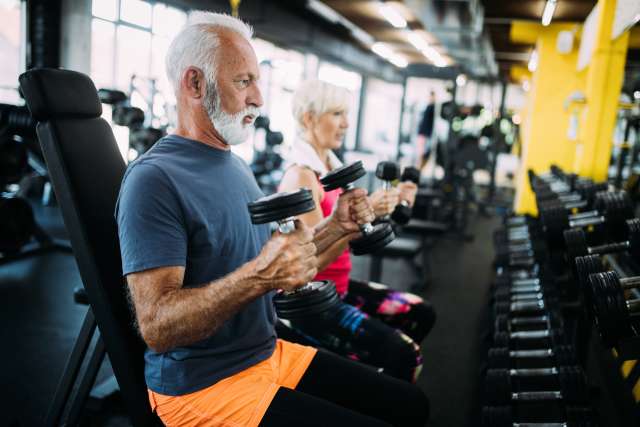Loss of muscle mass and strength is common as people age. But there are ways to maintain muscle as we get older — if one is willing to invest the time and effort.
“Loss of muscle as we age is a process we cannot avoid,” said Elisa Terry, associate director of fitness and well-being at UCLA Recreation. “We need to try to maintain as much muscle as we can. Resistance training is the only way to do that; it is the No. 1 exercise for seniors to retain muscle.”
Effective resistance exercises for seniors
Studies have shown that doing 20-to-30 minutes a day of resistance training, two or three days a week, can reduce the risk for sarcopenia, a condition that causes the muscles to lose mass and strength. In addition, resistance training also reduces risk factors for diabetes, cancer and osteoporosis.
To avoid injury, it is best to start slowly, with minimal weight, and work with a trainer, Terry recommended.
Some effective resistance exercises with which to start may include:
- Glute/hip bridge
- Plank (modified as necessary)
- Sit-to-stand or squat
- Seated or standing row
- Wall or countertop push-ups
- Bicep curls
- Triceps press down/extension
Terry recommended that anyone, regardless of age, begin a new training program slowly and gradually work toward higher levels.
“Someone who is starting with squats, for example, might want to first learn the mechanics of squatting by using their own body weight,” Terry said. “A senior may want to start with a sit-to-stand movement using a chair.”
Get moving!
One is never too old to start exercising, Terry said. “What does the word ‘senior’ even mean anymore? When I was younger, a senior was somebody over 50,” she said. “Now, 50 is the new 40. The bottom line is that people can get moving regardless of their age.”
In addition to preserving muscle, strength training can also slow the progression of osteoporosis, or loss of bone density, which often is experienced by postmenopausal women. It also can benefit women with fibromyalgia, a chronic disorder that causes tenderness and pain throughout the body. One study showed that women with fibromyalgia experienced a reduction in symptoms after 12 weeks of resistance training. Similar improvements have been found in people with arthritis.
Resistance training also can help stabilize joints and muscles to improve balance and reduce the risk of falling, which is a significant issue for adults as they age.
“It’s important, and I would suggest that every person who is able, regardless of their age, begin to do some type of strength training and maintain it throughout their life,” Terry said. “The stronger you can keep your muscles, the less wear and tear you’ll experience on your joints as you get older.”



